Messier Monday: The Eagle Nebula, M16
With the iconic pillars and fairy inside, this star-forming region in our galactic plane just might be the most spectacular of them all.
Image credit: ESO, via http://www.eso.org/public/images/eso0926a/.
“The most amazing lesson in aerodynamics I ever had was the day I climbed a thermal in a glider at the same time as an eagle. I witnessed, close up, effortlessness and lightness combined with strength, precision and determination.” –Norman Foster
The night is dark, but for those of us who’ve taken the time to get to know not only the stars and planets, but also the deep-sky objects that lie scattered across the skies, it’s full of wonder. To the first surveyers of the night skies with telescopes, faint, extended objects popped out in their fields-of-view, with the most common objects being open star clusters, globular clusters and distant galaxies lying well beyond our own. But also lying thousands of light-years away in the skies are star-forming nebulae, giving birth to the youngest, newest stars in the entire galaxy.
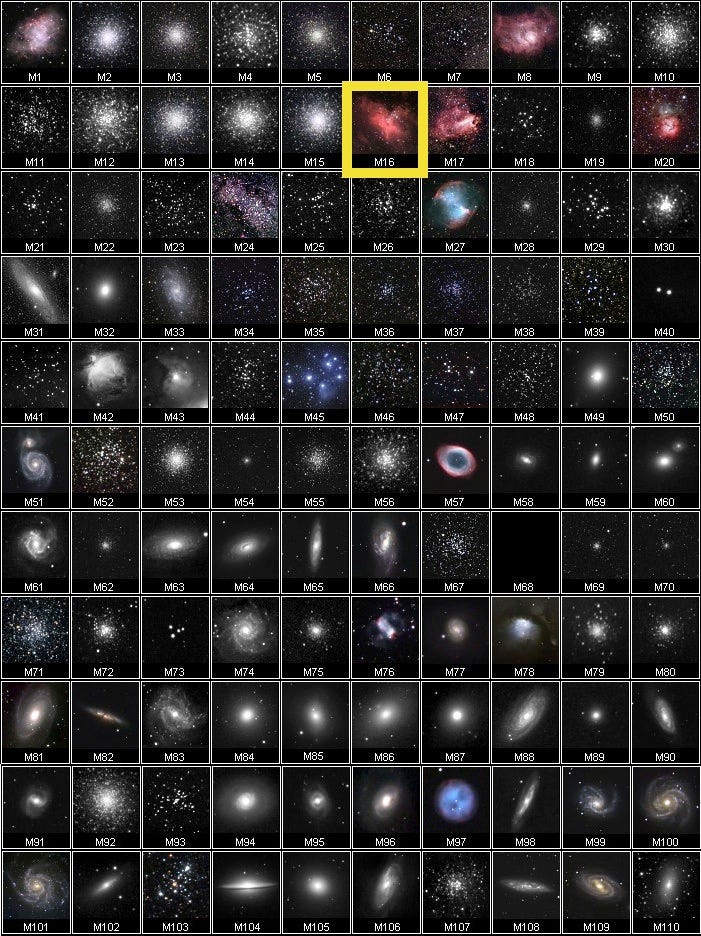
One of the most famous of these is the Eagle Nebula, the 16th object in Messier’s original catalogue of deep-sky objects. Like many star-forming regions, there already is a cluster of hot, young stars in there, and in fact that’s how this object was first discovered: by Jean-Philippe Loys de Chéseaux in the 1740s. It wasn’t for another two decades that the nebula was found, by Messier himself in 1764.
But the full wonder of this object is accessible to even amateurs with good skies, like the kind you’ll see shortly after sunset tonight. Here’s how to get there.

Fresh off its extraordinarily close encounter with a comet, Mars appears low over the southwest horizon just as the skies darken tonight. Just to the east of it, the collection of stars making the teapot in Sagittarius shines prominently. If you move either from Mars up towards the zenith or from the “top” of the teapot (the star Kaus Borealis) up away from its base — about 15° either way — you’ll find yourself in a region of space that’s relatively dark, but surrounded by bright stars.
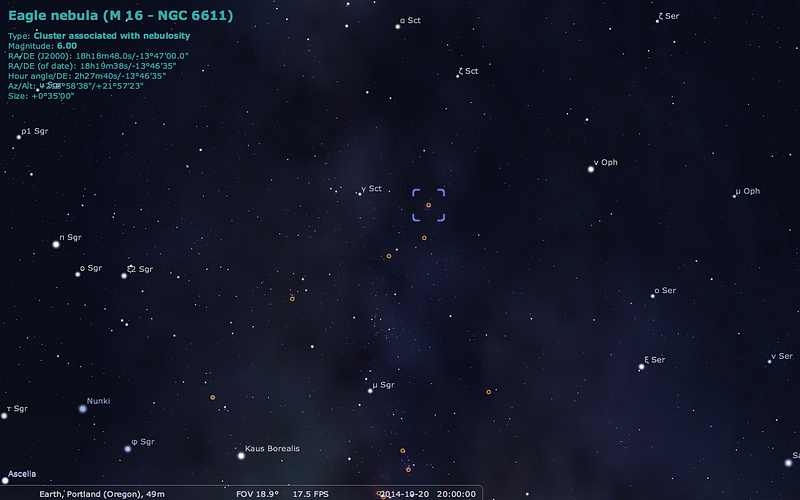
In particular, there are three stars at the edges of three different constellations that seem to engulf this dark area of the night sky: μ Sagittarii (at bottom-center, above), α Scuti (at top-center, above), and ν Ophiuchi (towards the right and slightly above-center). These are the three brightest stars in this region of space, and they’ll help guide you towards Messier 16, the Eagle Nebula.
If you draw an imaginary line connecting α Scuti to μ Sagittarii, you’ll find the fainter (but still clearly naked-eye) star γ Scuti just to the east of that line. And just 2.5° to the west of that line, where the line of stars that culminates in γ Scuti seems to point, lies Messier 16, the Eagle Nebula.
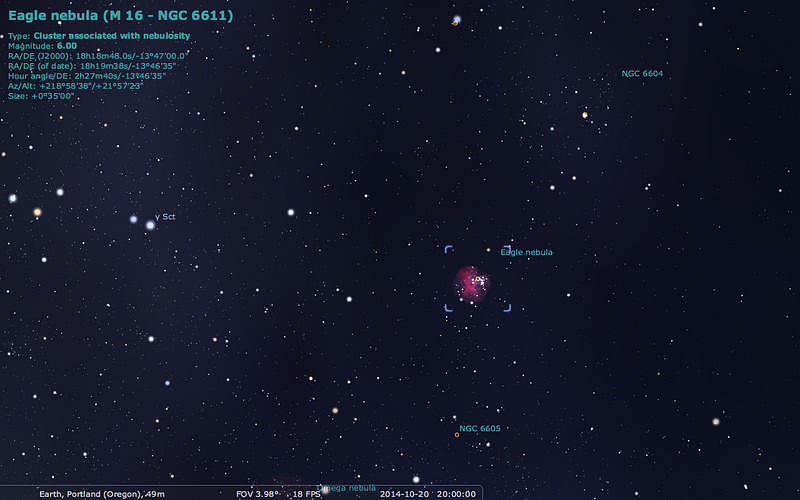
Looking through the best optics at his time, Messier was able to identify both a cluster and a nebula, although perhaps he didn’t seem all that confident in the latter, writing:
A cluster of small stars, enmeshed in a faint glow, near the tail of Serpens, at little distance to the parallel of Zeta of this constellation; with an inferior telescope this cluster appears like a nebula.
In fact, through a small, amateur telescope today, both the cluster and nebula are clearly visible.

The Eagle Nebula isn’t the brightest nebula in the sky, nor the closest, nor the youngest, nor is it the largest. In fact, it doesn’t even hold any of those distinctions among nebulae in the Messier Catalogue, of which there are only seven!
But the reason this object is so spectacular isn’t because of how extreme it is in any particular way, but because it simultaneously illustrates all of the different stages that occur in a star-forming region.
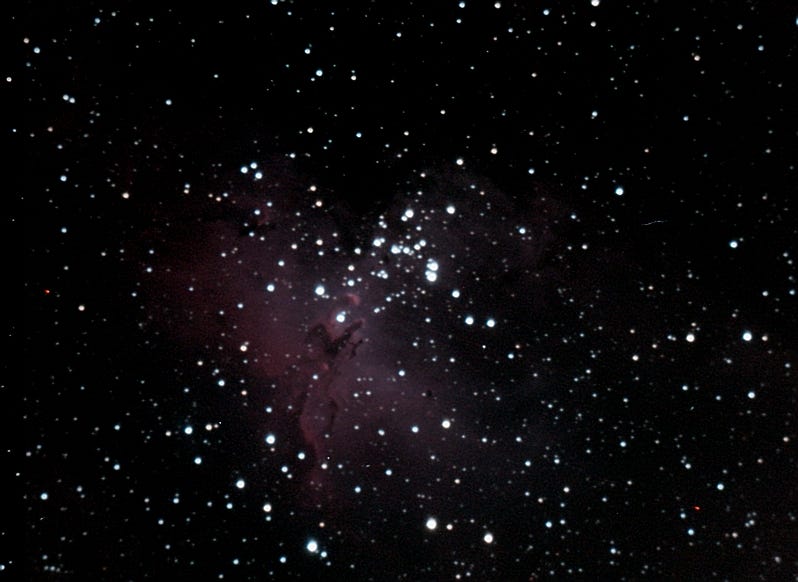
The cluster at the core of this nebula is on the small side, consisting of approximately 460 stars at last count, but dominated by a few bright, blue O-class stars, the most massive of which is approximately 80 times the mass of the Sun. Based on the bright stars that aren’t there, we can say that this cluster is at least a million years old, with parts of it likely older: perhaps between two and five-and-a-half million years for the oldest ones!
But young stars aren’t the only thing of note here; most of the region that appears the most “nebulous” is made out of hydrogen atoms that are constantly being ionized by ultraviolet radiation from these hot stars. And when the ionized electrons recombine with their atomic nuclei — protons, mostly — they emit a characteristic wavelength of light: 656.3 nanometers.

That’s the brightest emission line in the visible spectrum for hydrogen atoms, but if we looked in the ultraviolet we’d find an even stronger line! If this were one of the most pristine regions of gas in the young Universe, forming stars for perhaps the first time, hydrogen would be the vast majority of what’s there, with virtually no signs of atoms heavier than helium.
But other atoms in various ionized states also have characteristic emission lines at specific frequencies, and when we look for them, we find them in great abundance.

These elements include carbon, oxygen and sulphur, among many others. Both the young stars presently visible as well as the ones that still have yet to form in this nebula contain solar-system-like abundances of these heavy elements, meaning that — much like our neighborhood — we have every reason to believe that not only planets, but rocky planets with the raw ingredients for life abound with great frequency around practically every one of these new stars.

But one of the things I mentioned is one of the most spectacular things in the Eagle Nebula: the stars that have yet to fully form. There are a few regions in this nebula that consist of gas-and-dust of much greater density than normal. And it’s these regions where the ultimate cosmic race-against-time happens in earnest: the race between gravity to form and grow new stars, while radiation from all the stars both young and old works to heat up and accelerate that matter away, preventing further star growth.

Huge dust spires, like the “fairy” shown above, are indeed home to newly forming stars. Much lower in temperature than the hot surroundings of the interstellar medium making up the majority of the nebula, a cool region like this one has all the ingredients necessary to contract down and have the densest regions collapse, giving rise to new stellar life.
But the most spectacular region in this nebula — and perhaps the most famous photo of them all — belongs to the pillars of creation that lie within the Eagle Nebula.
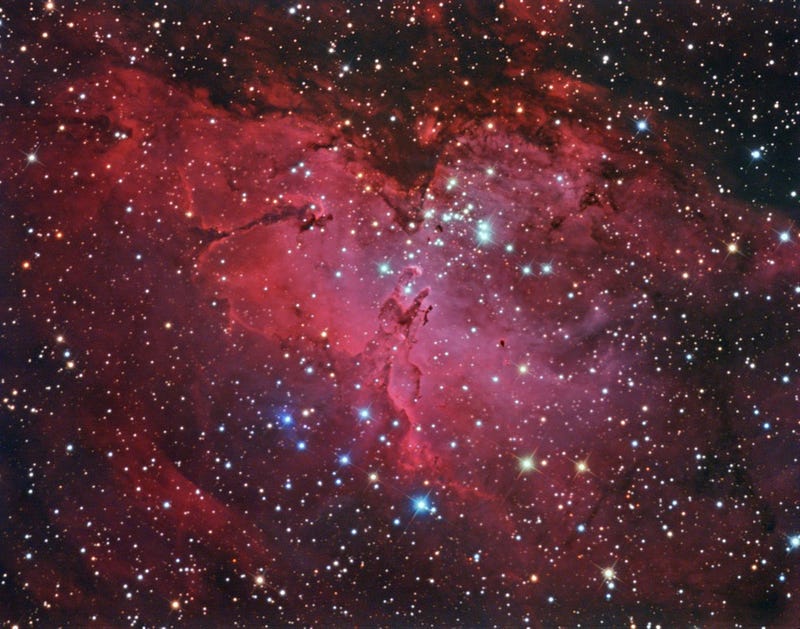
These three dust columns look like stalagmites to some, and different astrophotographers have focused on different properties, elements or features. But by far the most iconic image of all was taken in 1995 by Hubble, and is arguably the greatest Hubble image of all-time.

What you’re looking at is three competing processes going on at once:
- The neutral gas you see here working hard to collapse into gravitational clumps, with the largest clumps growing into the largest stars.
- The young proto-stars inside emitting intense radiation, destroying these pillars from the inside. In the peak of the largest spire, you can clearly see the starlight trying to peek through the gas.
- And finally, the ultraviolet radiation from outside the pillars, from the other hot stars in and around the nebula, works to evaporate the gas in the pillars externally.
You might think that the inference that there are significant numbers of proto-stars inside these pillars is too great an assumption, but direct images in the infrared:
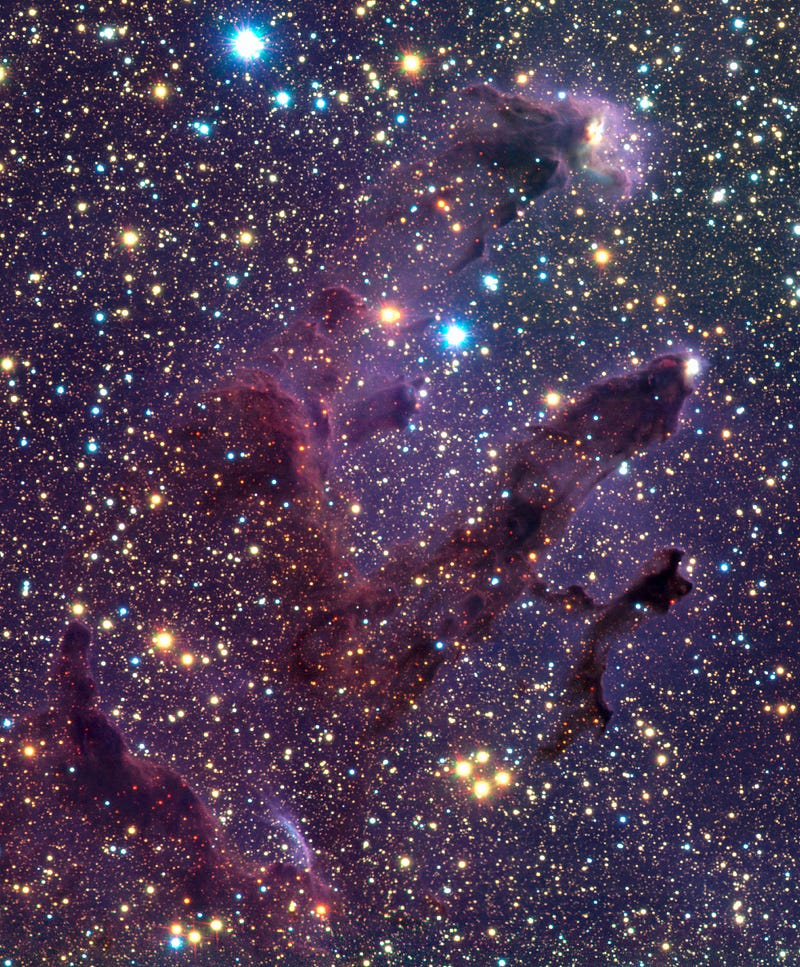
as well as from the Chandra X-ray Telescope — overlayed with the Hubble image, below — show that they’re really there!
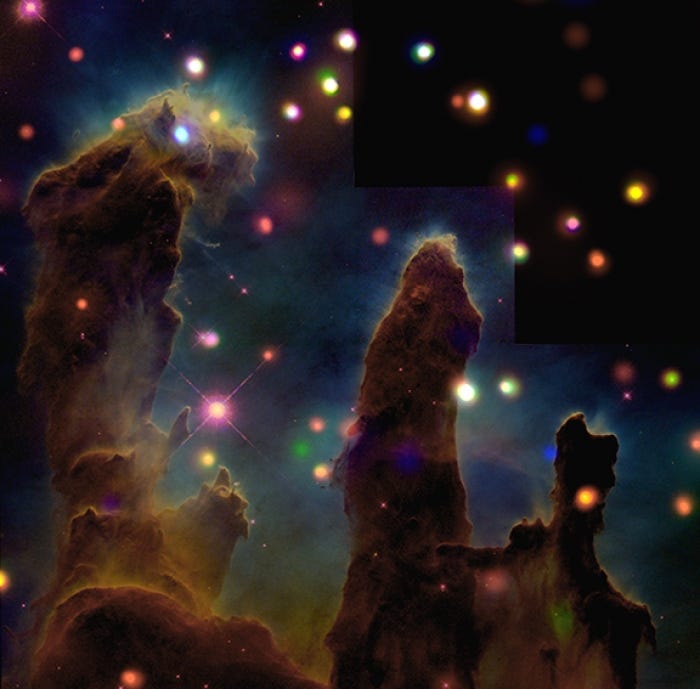
And that’s the fabulous story of the Eagle Nebula, in all its glory. From gas that’s still collapsing to active star formation to growing proto-stars to a young, fully-formed star cluster, this is one Messier object that has it all, and at some point in the next few hundred thousand years, will have a number of supernovae go off on top of it all!
And that will take us to the close of another Messier Monday. We’ve only got five objects left now, so don’t forget to take a look back at the 105 we’ve covered so far:
- M1, The Crab Nebula: October 22, 2012
- M2, Messier’s First Globular Cluster: June 17, 2013
- M3, Messier’s First Original Discovery: February 17, 2014
- M4, A Cinco de Mayo Special: May 5, 2014
- M5, A Hyper-Smooth Globular Cluster: May 20, 2013
- M6, The Butterfly Cluster: August 18, 2014
- M7, The Most Southerly Messier Object: July 8, 2013
- M8, The Lagoon Nebula: November 5, 2012
- M9, A Globular from the Galactic Center: July 7, 2014
- M10, A Perfect Ten on the Celestial Equator: May 12, 2014
- M11, The Wild Duck Cluster: September 9, 2013
- M12, The Top-Heavy Gumball Globular: August 26, 2013
- M13, The Great Globular Cluster in Hercules: December 31, 2012
- M14, The Overlooked Globular: June 9, 2014
- M15, An Ancient Globular Cluster: November 12, 2012
- M16, The Eagle Nebula: October 20, 2014
- M17, The Omega Nebula: October 13, 2014
- M18, A Well-Hidden, Young Star Cluster: August 5, 2013
- M19, The Flattened Fake-out Globular: August 25, 2014
- M20, The Youngest Star-Forming Region, The Trifid Nebula: May 6, 2013
- M21, A Baby Open Cluster in the Galactic Plane: June 24, 2013
- M22, The Brightest Messier Globular: October 6, 2014
- M23, A Cluster That Stands Out From The Galaxy: July 14, 2014
- M24, The Most Curious Object of All: August 4, 2014
- M25, A Dusty Open Cluster for Everyone: April 8, 2013
- M27, The Dumbbell Nebula: June 23, 2014
- M28, The Teapot-Dome Cluster: September 8, 2014
- M29, A Young Open Cluster in the Summer Triangle: June 3, 2013
- M30, A Straggling Globular Cluster: November 26, 2012
- M31, Andromeda, the Object that Opened Up the Universe: September 2, 2013
- M32, The Smallest Messier Galaxy: November 4, 2013
- M33, The Triangulum Galaxy: February 25, 2013
- M34, A Bright, Close Delight of the Winter Skies: October 14, 2013
- M36, A High-Flying Cluster in the Winter Skies: November 18, 2013
- M37, A Rich Open Star Cluster: December 3, 2012
- M38, A Real-Life Pi-in-the-Sky Cluster: April 29, 2013
- M39, The Closest Messier Original: November 11, 2013
- M40, Messier’s Greatest Mistake: April 1, 2013
- M41, The Dog Star’s Secret Neighbor: January 7, 2013
- M42, The Great Orion Nebula: February 3, 2014
- M44, The Beehive Cluster / Praesepe: December 24, 2012
- M45, The Pleiades: October 29, 2012
- M46, The ‘Little Sister’ Cluster: December 23, 2013
- M47, A Big, Blue, Bright Baby Cluster: December 16, 2013
- M48, A Lost-and-Found Star Cluster: February 11, 2013
- M49, Virgo’s Brightest Galaxy: March 3, 2014
- M50, Brilliant Stars for a Winter’s Night: December 2, 2013
- M51, The Whirlpool Galaxy: April 15th, 2013
- M52, A Star Cluster on the Bubble: March 4, 2013
- M53, The Most Northern Galactic Globular: February 18, 2013
- M54, The First Extragalactic Globular: September 22, 2014
- M55, The Most Elusive Globular Cluster: September 29, 2014
- M56, The Methuselah of Messier Objects: August 12, 2013
- M57, The Ring Nebula: July 1, 2013
- M58, The Farthest Messier Object (for now): April 7, 2014
- M59, An Elliptical Rotating Wrongly: April 28, 2014
- M60, The Gateway Galaxy to Virgo: February 4, 2013
- M61, A Star-Forming Spiral: April 14, 2014
- M62, The Galaxy’s First Globular With A Black Hole: August 11, 2014
- M63, The Sunflower Galaxy: January 6, 2014
- M64, The Black Eye Galaxy: February 24, 2014
- M65, The First Messier Supernova of 2013: March 25, 2013
- M66, The King of the Leo Triplet: January 27, 2014
- M67, Messier’s Oldest Open Cluster: January 14, 2013
- M68, The Wrong-Way Globular Cluster: March 17, 2014
- M69, A Titan in a Teapot: September 1, 2014
- M70, A Miniature Marvel: September 15, 2014
- M71, A Very Unusual Globular Cluster: July 15, 2013
- M72, A Diffuse, Distant Globular at the End-of-the-Marathon: March 18, 2013
- M73, A Four-Star Controversy Resolved: October 21, 2013
- M74, The Phantom Galaxy at the Beginning-of-the-Marathon: March 11, 2013
- M75, The Most Concentrated Messier Globular: September 23, 2013
- M77, A Secretly Active Spiral Galaxy: October 7, 2013
- M78, A Reflection Nebula: December 10, 2012
- M79, A Cluster Beyond Our Galaxy: November 25, 2013
- M80, A Southern Sky Surprise: June 30, 2014
- M81, Bode’s Galaxy: November 19, 2012
- M82, The Cigar Galaxy: May 13, 2013
- M83, The Southern Pinwheel Galaxy, January 21, 2013
- M84, The Galaxy at the Head-of-the-Chain, May 26, 2014
- M85, The Most Northern Member of the Virgo Cluster, February 10, 2014
- M86, The Most Blueshifted Messier Object, June 10, 2013
- M87, The Biggest One of them All, March 31, 2014
- M88, A Perfectly Calm Spiral in a Gravitational Storm, March 24, 2014
- M89, The Most Perfect Elliptical, July 21, 2014
- M90, The Better-You-Look, The Better-It-Gets Galaxy, May 19, 2014
- M91, A Spectacular Solstice Spiral, June 16, 2014
- M92, The Second Greatest Globular in Hercules, April 22, 2013
- M93, Messier’s Last Original Open Cluster, January 13, 2014
- M94, A double-ringed mystery galaxy, August 19, 2013
- M95, A Barred Spiral Eye Gazing At Us, January 20, 2014
- M96, A Galactic Highlight to Ring in the New Year, December 30, 2013
- M97, The Owl Nebula, January 28, 2013
- M98, A Spiral Sliver Headed Our Way, March 10, 2014
- M99, The Great Pinwheel of Virgo, July 29, 2013
- M100, Virgo’s Final Galaxy, July 28, 2014
- M101, The Pinwheel Galaxy, October 28, 2013
- M102, A Great Galactic Controversy: December 17, 2012
- M103, The Last ‘Original’ Object: September 16, 2013
- M104, The Sombrero Galaxy: May 27, 2013
- M105, A Most Unusual Elliptical: April 21, 2014
- M106, A Spiral with an Active Black Hole: December 9, 2013
- M107, The Globular that Almost Didn’t Make it: June 2, 2014
- M108, A Galactic Sliver in the Big Dipper: July 22, 2013
- M109, The Farthest Messier Spiral: September 30, 2013
With a bright, young Moon out next week (and Halloween approaching), the skies will have an awful lot to offer. Don’t miss next Monday’s treat, and until then, enjoy your skies!
Leave your comments at the Starts With A Bang forum on Scienceblogs!





